How to Sharpen a Knife: Ultimate Kitchen Guide
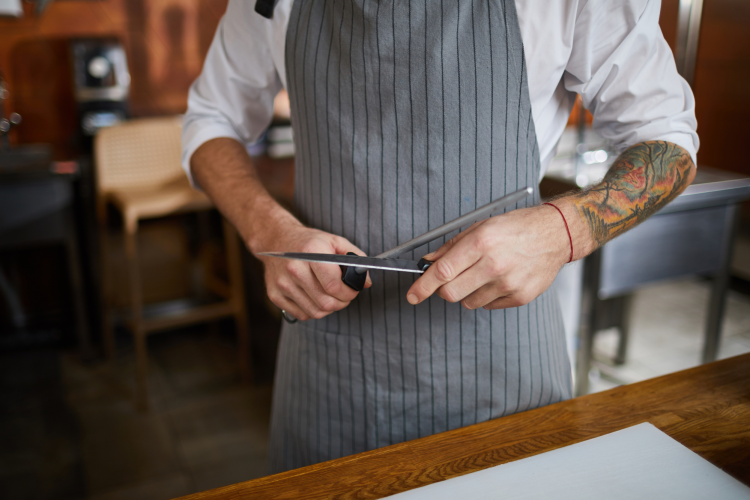
If you’re an amateur chef, you might have been honing your cooking skills for years, but do you really know how to sharpen a knife? It’s a kitchen task that seems simple enough, but for many home cooks, sharpening knives is an intimidating process. It can be difficult to know what tools you need, how to hold the knives appropriately, and what sharpening methods work best for what knives.
At the end of the day, learning how to sharpen a knife is one of the most useful skills any home chef can have. Not only will sharper knives make your kitchen prep easier, but it will make your time in the kitchen safer. Dull knives are incredibly dangerous, so it’s worth learning how to sharpen a knife at home to avoid any accidents when you’re prepping your next dinner party. And while there are many, many types of kitchen knives out there, the tools and steps for sharpening them are fairly constant and straightforward. This guide will show you some of the most common tools and practices for keeping your knives in top shape.
Jump to Section
- How to Sharpen a Knife With a Stone
- How to Sharpen a Knife With a Rod
- How to Use a Knife Sharpener
- How to Sharpen a Serrated Knife
- How to Sharpen a Knife Without a Sharpener
- Our Favorite Knife Sets
How to Sharpen a Knife With a Stone
You can find an array of kitchen hacks to get up to speed with if you're looking to keep your knife collection sharp. If you’re just learning how to sharpen a knife, the best place to start is with the most traditional method: a whetstone. This is the tried and true method for sharpening most knives, and you can find sharpening stones in many different varieties and prices. Most whetstones have two sides, a coarser side and a finer side. Think of these varying coarseness levels like different grits of sandpaper. They each serve a purpose in sharpening the blade of your knife.
In order to know how to sharpen a knife with a whetstone, it’s important to read the instructions on your particular stone, but here are some general tips. First, most stones need to be wet in order to be used properly. This means you’ll need to completely submerge the stone in water before you do it. You should also have some water on hand as you’re sharpening your knife so that you can re-wet the stone if it starts to dry out.
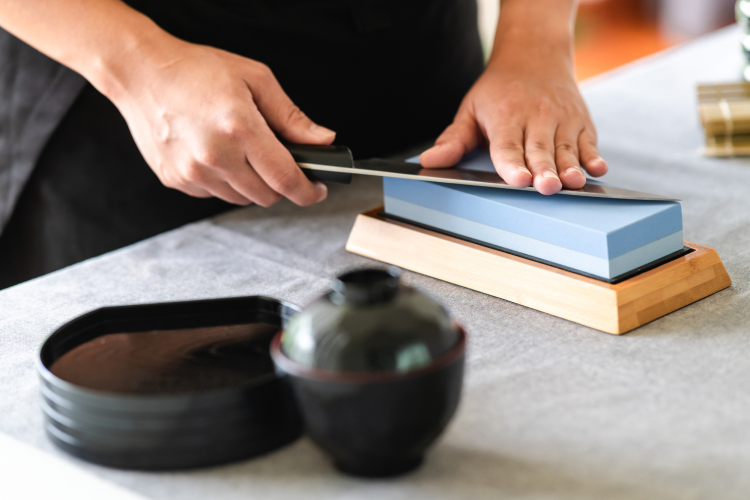
Once your stone is soaked through, be sure you have a safe way to keep it secure, whether it comes with a handle or you use a towel or rag to hold it steady. Then, start with the coarsest side of the stone. Hold your knife at a 15 to 20 degree angle, and slide the blade along the stone a few times. Be sure to flip the blade over and sharpen the other side, as well.
Once you’ve sharpened the blade with the roughest side of your stone, flip the stone over and repeat the process with the finer side. This will ensure that the blade of your knife is razor sharp. If your knives are quite dull, you’ll need to go through this entire process, but if you regularly use a stone or other tool to keep your knives sharp, you may not need to use the coarse side of the stone at all. Instead, use the fine side right away to keep your knives well-maintained.
Of course, as you grow in your knowledge of knives and knife maintenance, you’ll find that there’s an almost endless variety of sharpening stones out there! These simple tips are a great starting point for anyone who is just learning how to sharpen a knife or how to sharpen a knife with a whetstone.

How to Sharpen a Knife With a Rod
You can consult any knife guide to know what types of blades are best for different cooking methods, but even the best guides might not explain the difference between sharpening your knives and honing the blades. If you don’t have a stone at home and are still wondering how to sharpen a knife, try using a honing rod. Honing keeps the edge of the knife straight, whereas sharpening the knife makes the blade thinner and — you guessed it — sharper. You should know that honing your blades won’t sharpen your knives as well as a traditional stone or another sharpening tool, but it will help extend the life of your knives. In fact, it might even make your dinner preparations a little smoother, even if you don’t have time to actually sharpen your knives. It’s a good idea to hone your knives weekly, while sharpening should be a rarer (think monthly or even yearly) task, depending on the quality of your knives.

Honing rods come in two main varieties: ceramic and steel. Ceramic honing rods are best for getting a razor sharp edge on thin blades. Steel rods are best for honing thicker blades and smoothing out imperfections in your knives.
With all of that in mind, here’s how to sharpen a knife with a rod. First, place one end of the rod on your counter or table, being sure to hold it securely in a vertical position. Then, place the base of the knife against the honing rod and move the blade down the rod, pulling the knife towards your body as you do, so that the entire curve of the blade comes into contact with the rod. It’s best to maintain a 15-20 degree angle in the knife as you do this. Once you’ve done one side of the knife, repeat with the other side as well.
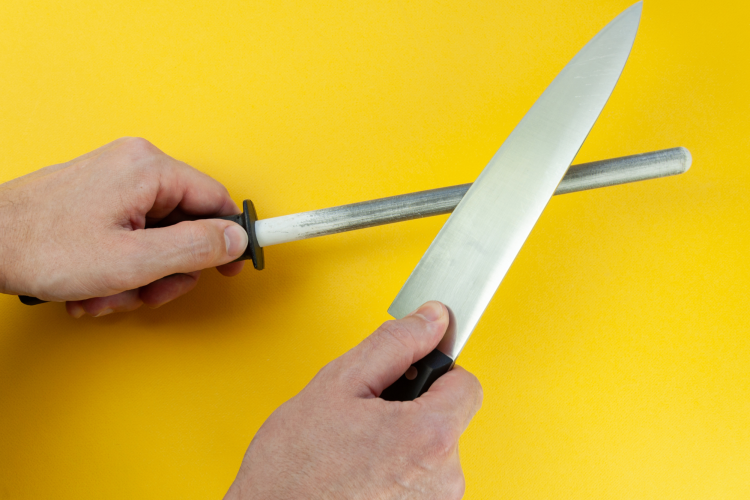
How to Use a Knife Sharpener
If you are short on time or simply aren’t sure how to sharpen a knife manually, you can always purchase a handheld knife sharpener at most retail stores. There are many options to choose from, including basic pull-through sharpeners or fancier electric knife sharpeners. You can even find knife sets that come with a sharpener, like the Zwilling Pro 7 Pc Block With Sharpener. Whatever option you choose, here are instructions for how to use a knife sharpener.
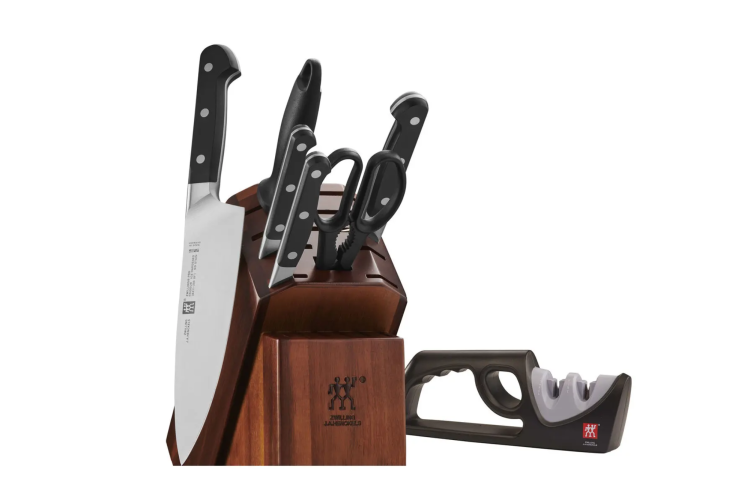
To use your knife sharpener, first be sure that it is secured to your work surface. Then identify which slot on the sharpener is the coarse side and which is the fine side. Every handheld sharpener should have at least two slots, though some options have more. Just like with the whetstone method, use the coarsest setting first to reshape the blade. Insert the base of your knife into the slot, and be sure to press down as you pull the knife through the slot towards your body.
As you move the blade through the slot, follow the curve of its blade to be sure every part of the edge comes into contact with the sharpener. You should be able to hear the grinding sound of the blade moving through the sharpener. Do this between 3-6 times, depending on how much sharpening your blade needs. To finish, switch to the fine side, and repeat the same process. This will get the blade of your knife back to its sharpest condition, and is great, especially if you’re still learning how to sharpen a knife using the other methods on this list. Once you’ve sharpened the blade, be sure to rinse and dry it well, since sharpening the blade removes tiny amounts of steel.
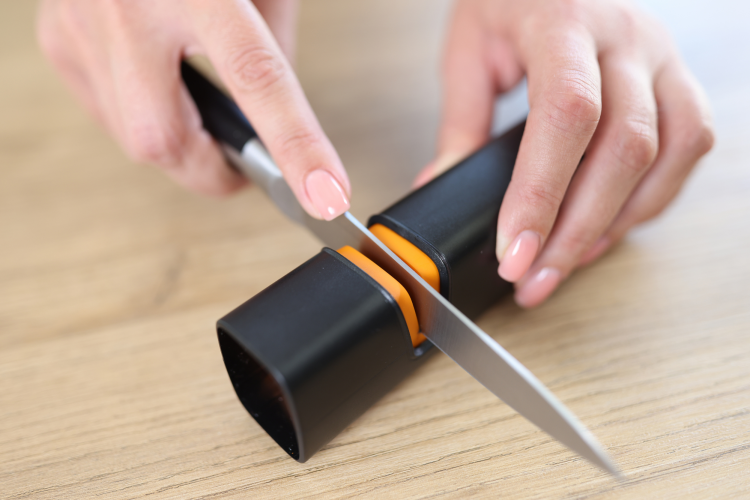
How to Sharpen a Serrated Knife
It can be difficult enough knowing how to sharpen a kitchen knife, but knowing how to sharpen a serrated knife is even trickier. Serrated knives seem, on first glance, to be unsharpenable. How can you use a whetstone or handheld sharpener when the blade has multiple sharp points? Is there a way to easily sharpen a serrated knife at home?
The good news is that a high-quality serrated knife doesn’t need to be sharpened as often as the other knives in your set. In fact, because of the way serrated knives work, they’ll actually function well even if the blades are a little dull. But eventually even the best kitchen knives need to be sharpened, so if you find that your serrated blade isn’t cutting through bread as easily as it used to, don’t worry. In order to sharpen your serrated knife, simply grab your honing rod and be sure you have a little bit of time on your hands. It’s best to use a ceramic rod for this type of sharpening, because you’ll need to get each serration razor sharp.

To sharpen your knife, place the ceramic rod in the first serration at the base of the knife. Find the right angle by matching up the rod to the bevel you’ll see on the inside of the serration. Then slide the rod through the serration towards the cutting edge of the knife. You’ll need to repeat this step for each serration on the blade, which is why it can take some time. When you’re done sharpening each serration, be sure to flip the blade over and look at the flat side. You may need to use your whetstone to remove any burrs, or small formations of steel, that you’ve dislodged while you were sharpening each groove on the other side of the knife.
How to Sharpen a Knife Without a Sharpener
If you don’t have any sharpener or stone on hand, how can you sharpen a knife? There’s a kitchen hack that’s been popping up on the internet recently that teaches you how to sharpen a knife without a sharpener. To use this hack, all you’ll need is a ceramic mug or dish. You might have noticed that the honing rods we mentioned above are either made of ceramic or steel. This sneaky kitchen hack allows you to avoid buying a ceramic honing rod and simply use the ceramic dishes you already have on hand.
To learn how to sharpen a knife this way, flip your ceramic mug or dish over and find the rough edge on the bottom. Then, simply draw the blade of your knife over the rough ceramic surface like you would another sharpening tool, being sure to follow the curve of the blade so that the entire edge comes into contact with the ceramic. Do this a few times on each side of the blade, and your knives will be sharpened with little to no hassle.
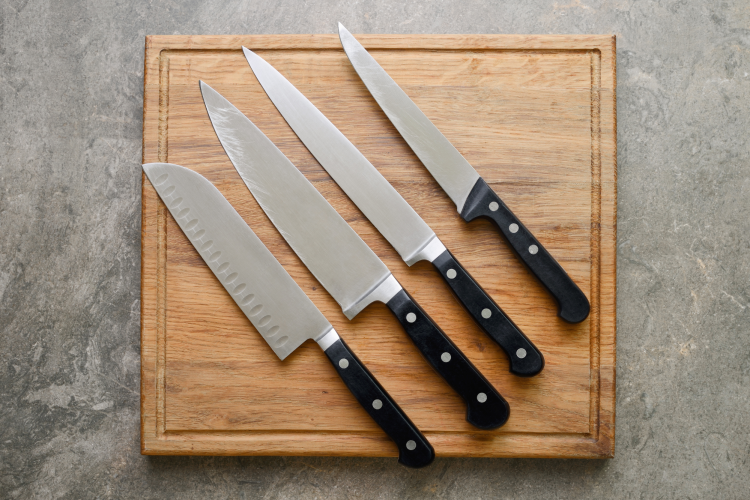
Our Favorite Knife Sets
When you’re ready to add razor-sharp precision to your cutlery collection, shop our favorite knife sets:
- Miyabi Birchwood SG2 7 Pc Knife Block Set
- Cuisine::pro Damashiro Emperor Hisa 9-Piece Knife Block Set
- Zwilling Pro 6-Pc Knife Block Set
- Zwilling TWIN Four Star II 7pc Knife Block Set
- Cuisine::pro Damashiro Nami 9-Piece Knife Block Set
We hope this guide took some of the confusion out of knowing how to sharpen a knife. Whether you’re using a whetstone or an electric sharpener, be sure to keep your knives sharpened regularly to avoid injuries in the kitchen and to make slicing and dicing easier.
For even more ways to elevate your kitchen, check out chef-recommended cutlery in the Cozymeal Shop.



FOOD FOR THOUGHT?
Join the conversation.